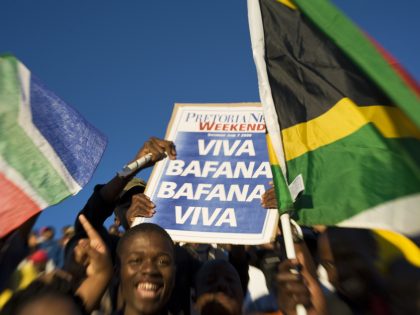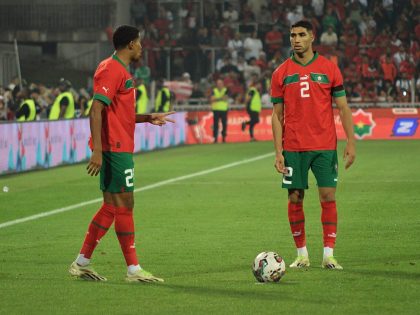The Spear of the People
The KwaZulu-Natal Midlands has a bit of a reputation as a “sleepy hollow.” But it was a crucial node in the struggle against apartheid.

Die Bafanas perform from a truck outside Jan Smuts cricket stadium demonstrating against rebel English tour 1990 (Rafs Mayet, Africa South Art Initiative Culture and Working Life Project)
In September this year, Inkosi Mhlabunzima Maphumulo would have turned 65 years old. But on February 25, 1991, an apartheid hit squad murdered the traditional leader and Contralesa president as he pulled into the driveway of his home. Maphumulo’s assassination sent shockwaves across the Pietermaritzburg communities that had come to know him as the “peace chief” for his efforts to quell KwaZulu-Natal’s political violence.
During the last decade of apartheid, Pietermaritzburg was the scene of some of South Africa’s deadliest violence as a state-fueled civil war wracked its townships and countryside. Pietermaritzburg is the city where Nelson Mandela gave his last speech before his 1962 arrest. It is the birthplace of the ANC’s fiery and controversial Harry Gwala and the Liberal Party leader and novelist Alan Paton.
Despite this, the KwaZulu-Natal Midlands and its capital city, Pietermaritzburg, have a bit of a reputation as a “sleepy hollow.” But a group of local artists, activists, and business people are working to change that perception. The people working to promote Pietermaritzburg’s history and arts are a diverse group, forming a partnership between business people, local government, and artists. I sat down with two of them, businesswoman Amanda Xaba and the playwright Mzi Mngadi, to discuss the fruit of their collaboration, the stage production Umkhonto Wabantu.
Amanda Xaba started a communications company in 2006 and named it after her grandfather, local struggle hero Anton “Mfenendala” Xaba. In 2012, the company formed a trust to manage his legacy and launched a corporate magazine. Besides local business coverage and lifestyle advice, each issue features one of Pietermaritzburg’s struggle heroes, starting with her grandfather and including Maphumulo, Gwala, Jabu Ndlovu, and Chota Motala. In one issue, Xaba described the impetus for promoting Pietermaritzburg’s history: “When I asked my son who or what Moses Mabhida was he answered, ‘the stadium in Durban.’”

They also launched the Mfenendala Cultural Arts Group, adopting the Pietermaritzburg Artists Association with financial support in order to educate more people about the role of Pietermaritzburg in the liberation struggle.
The Pietermaritzburg Artists Association, formerly known as “Die Bafanas” was founded by Sipho Mthembu, Khaba Mkhize, and Muzi Mthembu in the 1980s as a black community theatre with a focus on political education. They also performed several of Mkhize’s plays, including Hobo the Man, Pity Maritzburg!, and Ubuntu. The Association’s current director, Nelson Thulani Mngadi, grew up steeped in the city’s theatre. Die Bafanas used to practice at his house. He remembers watching: “I think maybe I was about seven years old seeing those veterans on stage. Most of them were my role models and mentors. I admired everything about them and learnt a lot. The old Sobantu generation was very talented and passionate about stage plays, musical, theatre and sports.”
Die Bafana’s community education mission continues in the association’s partnership with Mfenendala for Umkhonto Wabantu. Mfenendala reached out to the association and the Sobantu school teacher, poet, novelist, and three-time Comrades race medalist, Mzi Mngadi. They gave Mzi the magazine articles on local struggle heroes and the accompanying research… and asked for a story.
Mzi’s Umkhonto Wabantu highlights the history of KwaZulu-Natal Midlands, carefully covering a tumultuous era of South Africa’s past while celebrating the region’s liberation heritage without hagiography. The first day of the production was reserved for high school and tertiary learners, whose tickets were covered by some funding from the National Heritage Council. I attended the second showing on 27 June 2014. The Winston Churchill Theatre filled with local dignitaries, university faculty and students, heritage representatives, and the families of those featured.
Umkhonto Wabantu dealt emotively with the tragic moments of KwaZulu-Natal’s history. When I brought up the range of emotions evoked by the drama, Mzi called it a “salad,” echoing the sentiment that Khaba Mkhize offered up 20 years earlier to describe another Pietermaritzburg community theatre production, his Pity Maritzburg!
Pity Maritzburg was written by the events, not me. It was like a fruit salad. You take the apple, slice it, put it there, you take paw-paw, y’know.” – Khaba Mkhize in “Natal Cockroaches Fly”
While the events and characters may have written Umkhonto Wabantu, Mzi gave it beautiful form. He used Zulu storytellers to set up each scene. Thami Gumede paced the stage as an imbongi and even in English mimicked the pace of a Zulu praise singer. Winile Madlala, in her MK uniform, was much more reserved but equally powerful. The chorus animated the theatre with its performances of the songs of the liberation struggle.
With Umkhonto Wabantu Mzi told the region’s history as the families of those portrayed sat in the front row. Mngadi expressed his concerns about the audience: “I had fears about that before the play. It’s not easy to unleash or construct something that is about people with relatives still living.” But there was nary a dry eye as four soldiers pushed the coffin of Victoria Mxenge, draped in an ANC flag, across the stage and violence ensued. I sat next to Inkosi Maphumulo’s daughter as Siphamandla Ngcobo strode confidently across the stage as the late chief. All knew immediately who it was – not necessarily because of the head ring denoting his leadership status, but on account of his infamous leather jacket. Buyi chuckled and whispered, “they got that right!”
There were other laughs too. By far the evening’s lightest moments surrounded Mandla Mbuyisa’s portrayal of Harry Gwala, wearing the signature neck brace and thick glasses. Mbuyisa would bellow, “viva, ANC, viva!” and the crowd erupted. The audience also loved Phumlani Madlala as PACSA’s Peter Kerchoff – though the playwright may have taken some liberties with Kerchoff’s politics.
As Umkhonto Wabantu remembers these local struggle heroes—the late peace chief, comrade Gwala, and Mfenendala—it reminds that the sleepy hollow isn’t so sleepy.




















